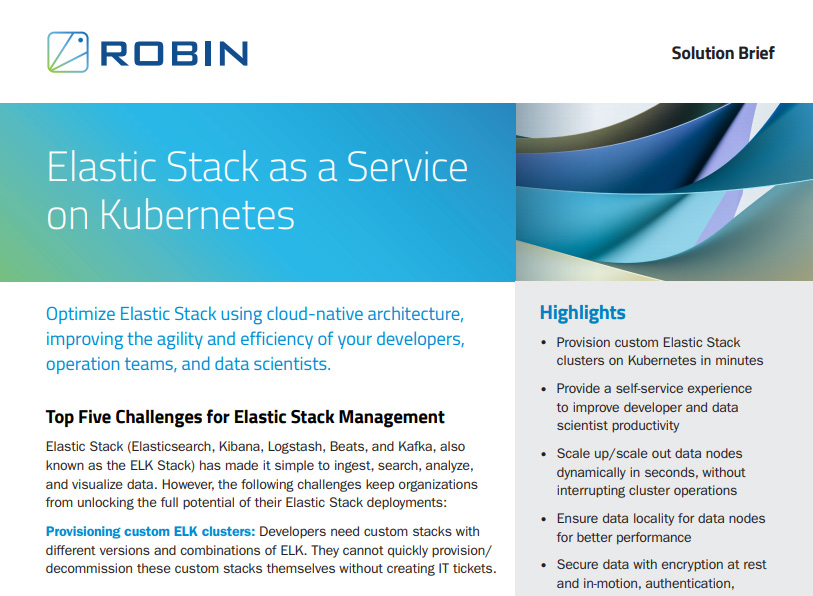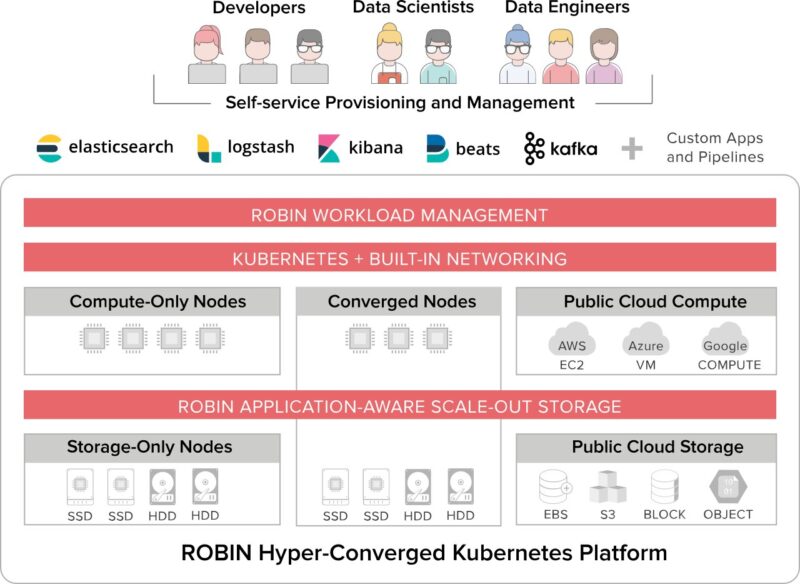Elastic Stack-as-a-Service with Kubernetes Solution Brief


Turbocharge your Elastic Stack infrastructure using cloud-native architecture. Improve the agility and efficiency of your Developers, Operation teams, and Data Scientists.
Highlights
»Provision custom Elastic Stack clusters on Kubernetes in minutes
»Provide self-service experience to improve developer and data scientist productivity
»Scale-up/scale-out Data Nodes dynamically in seconds, without interrupting cluster operations
»Ensure data locality for Data Nodes for better performance
»Secure your data with encryption at rest and in-motion, authentication, and RBAC
»Ensure high availability using rack-aware placement rules for Master and Data Nodes
»Consolidate multiple ELK clusters on shared infrastructure to reduce hardware footprint
»Trade resources among ELK clusters to manage surges and periodic compute requirements
Top 5 Challenges for Elastic Stack Management The Elastic Stack has made it simple to ingest, search, analyze, and visualize data. However, following challenges keep organizations from unlocking the full potential of the Elastic Stack:
»Monolithic ELK clusters: Giant shared ELK clusters slow down developers and data scientists because they cannot make the necessary customizations (e.g. a specific versions of Elasticsearch, or Beats).
»Provisioning custom ELK clusters: Developers need customs stacks with different versions and combinations of Elasticsearch, Logstash, Kibana, Beats, and Kafka. They cannot quickly provision/decommission these custom stacks themselves, without creating IT tickets.
»Dynamic scaling to meet sudden demands: If a Data Node runs out of resources, there is no easy way to scale-up the node “on-the-fly” by adding more memory or CPU. Scaling-out to add more Data Nodes can also take weeks due to process delays.
»Security concerns: Without encryption at rest, your data is vulnerable. All data should be treated as sensitive, and be secured.
»Multi-cluster strategy leads to massive hardware costs: Creating dedicated clusters for individual “tenants” (teams, workloads, applications etc.) is a good strategy. But requires provisioning each cluster for peak capacity, leading to significant hardware underutilization. Robin Platform Enables “As-a-Service” Experience Robin is a Software Platform for Automating Deployment, Scaling and Life Cycle Management of Enterprise Applications on Kubernetes. Robin automates the provisioning and day-2 operations so that you can deliver a “Self-Service” experience with 1-click deployment simplicity for developers, DBAs, and Data Scientists


Solution Benefits and Business Impact
Robin brings together the simplicity of hyper-convergence and the agility of Kubernetes.
Deliver Insights Faster
Self-service experience
Robin provides self-service provisioning and management capabilities to developers, operations teams, and data scientists, significantly improving their productivity. It saves valuable time at each stage of application lifecycle.
Provision custom stacks in minutes
Robin has automated the end-to-end cluster provisioning process for the Elastic Stack, including custom stacks with different versions and combinations of Elasticsearch, Logstash, Kibana, Beats, and Kafka. The entire provisioning process takes only a few minutes.
Eliminate “right-size” planning delays
DevOps and IT teams can start with small deployments, and as applications grow, they can add more resources. Robin runs on commodity hardware, making it easy to scale-out by adding commodity servers to existing deployments.
Scale on-demand
No need to create IT tickets wait for days to scale-up Data Nodes by adding more memory, CPU, or Storage, or to scale-out by adding more Data Nodes. Cut the response time to few minutes with 1-click scale-up and scale-out.
Reduce Costs
Improve hardware utilization
Robin provides performance isolation and role-based access controls (RBAC) to consolidate multiple ELK workloads without compromising SLAs and QoS, increasing hardware utilization and reducing cost. Ensuring data locality for Data Nodes also provides better performance, reducing hardware footprint.
Simplify lifecycle operations
Native integration between Kubernetes, storage, network, and application management layer enables 1-click operations to provision, scale, snapshot, clone, backup, migrate ELK clusters, reducing the administrative cost.
Trade resources among ELK clusters
Reduce your hardware cost by sharing the compute resources between clusters. If an ELK cluster runs the majority of its batch jobs during the night-time, it can borrow a resource from an adjacent ELK cluster with day-time peaks, and vice versa.
Future-proof your Enterprise
Standardize on Kubernetes
Modernize your data infrastructure using cloud-native technologies such as Kubernetes and Docker. Robin solves the storage and network persistency challenges in Kubernetes to enable provisioning and management of mission-critical ELK deployments. Robin also eliminates the need to manually define and manage individual K8S configuration objects such as PVC, PV, StatefulSets, Services, etc.
No cloud lock-in
Kubernetes-based architecture gives you complete control of your infrastructure. With the multi-cloud portability, you have the freedom to move your workloads across private and public clouds, you avoid vendor lock-in.
Enterprise-grade security and HA
Robin provides encryption at rest out of the box, bringing an extra layer of security. Rack-aware placement rules for Master and Data Nodes ensures your HA setup is production-ready.
